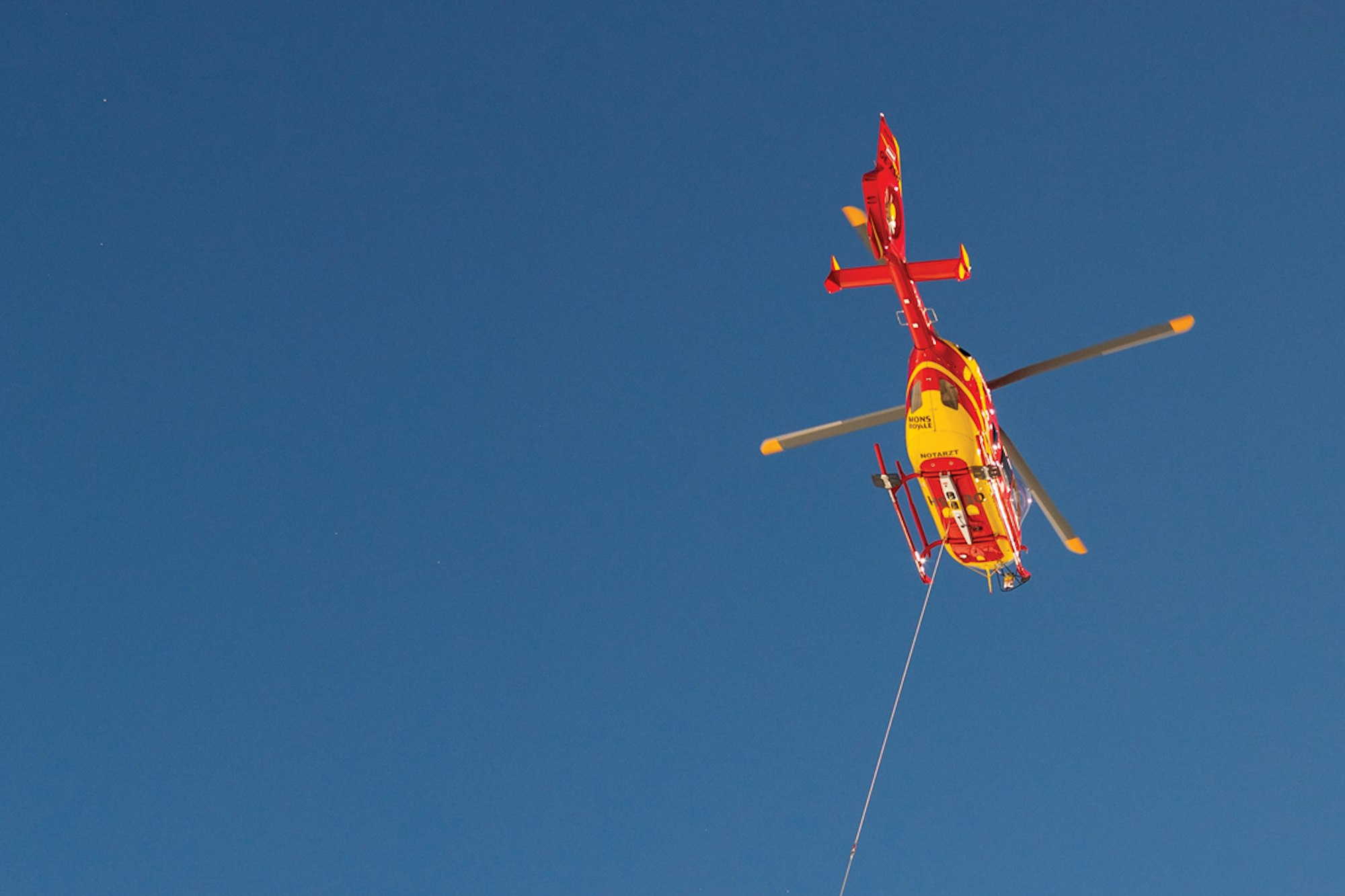Pro skier Sam Smoothy wrestles with his decision-making processes after a close call in the Austrian Alps
WORDS • Sam Smoothy | PHOTOS • Chris Bezemat
June 2018.
Perusing the latest spuriously-sourced read about Miley Cyrus’ heartbreak on an Italian beach, something far more insidious crawled into my brain. Then, the lights turned out. I woke up alone in an ambulance and played a charming game of charades to discover I had suffered my first seizure. Curious times indeed. Back home in New Zealand, the next few months floated by in a haze of unenlightening brain scans and disturbing memory lapses. I was adrift on a sea of intangible malaise and nobody knew why. Where the fuck had I put my paddle?
Finding no cause for the seizure but noting a history of head injuries, my doctor requested I eliminate activities where having another seizure would endanger myself or others. With extra points for not hitting my head again. A now-medicated man, I tried to comply through selective skiing and a focus on other activities.
Gearing up for the Northern Hemisphere winter, I felt like my old self again, training hard and setting goals. I wanted to put out an old school blood-and-guts section of just filthy lines filming with Teton Gravity Research. I felt I had never accomplished what I was capable of on film and was determined to change that. But above all else, I wanted to stay healthy and not take another shot to the dome. Simple.
Austria was going off, huge snow falls plastered Alaska-like spines onto big walls by mid-January and we were teeing off for the cameras. With a few choice lines already ticked, I went back up alone for another, more exposed line. A small slab avalanche popped as I dropped, not unexpectedly, and my spine safety zone worked fine as I waited for clearance to escape. Casually skiing down after, I hopped onto the exit spine, got hooked up in the avalanche-exposed crust and was tossed 20 meters onto rocks, landing backwards on my back and head. I was out cold and not breathing when help arrived and had another seizure before being quickly heli-evacuated to the hospital. My destroyed helmet and pack saved my life and spine, and while I was able to walk out of the hospital with only wholesale hematomas around my back and pelvis, my hand still shakes thinking about that hit. Where had I gone wrong?
Looking back, I believe my internal monologue had deceived me. I thought I was following my processes, assessing the conditions and my own state accurately. But now I see that my own ambition and ego had slyly overridden my ability to manage risk. Even once the face had slid, I was too casual in the exposure and too confident in my ability, my arrogance confirmed by my previous heroics skiing the zone. My ego had slid in the backdoor unnoticed and fucked me hard, while my friends sat there and watched. And then they had to clean up the unsavory mess. For just one more line on film, I had risked everything I love, and nearly lost it all.
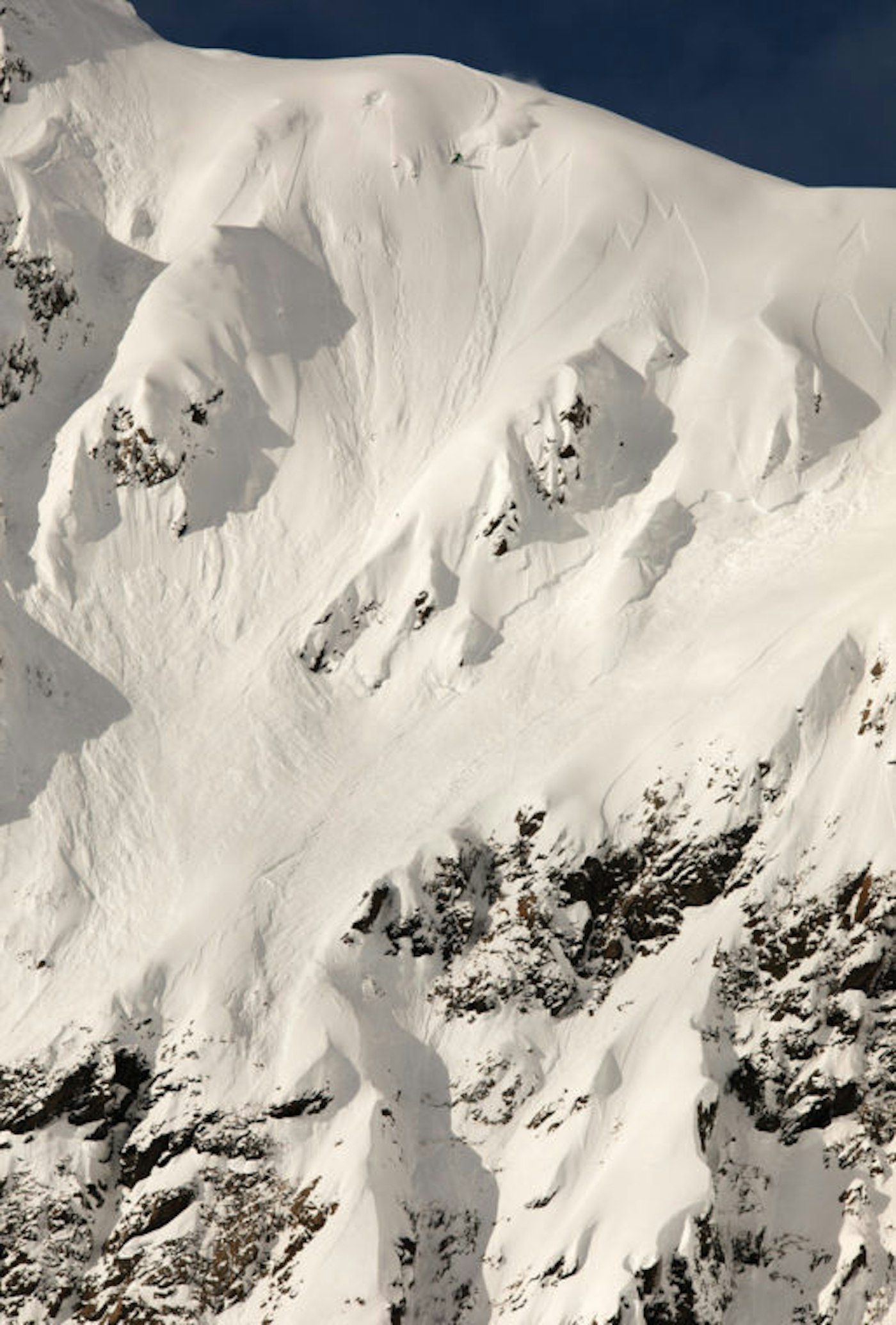
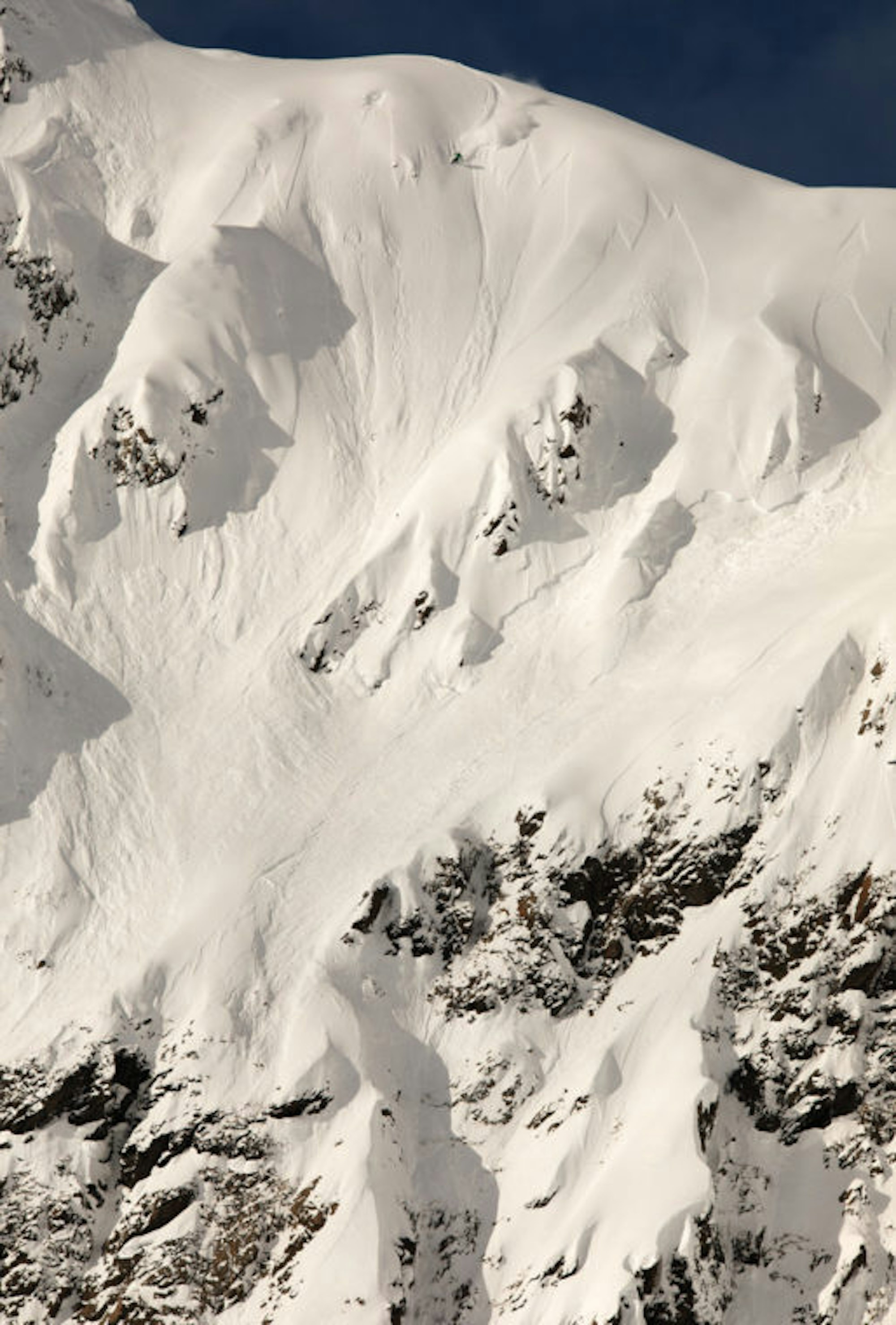
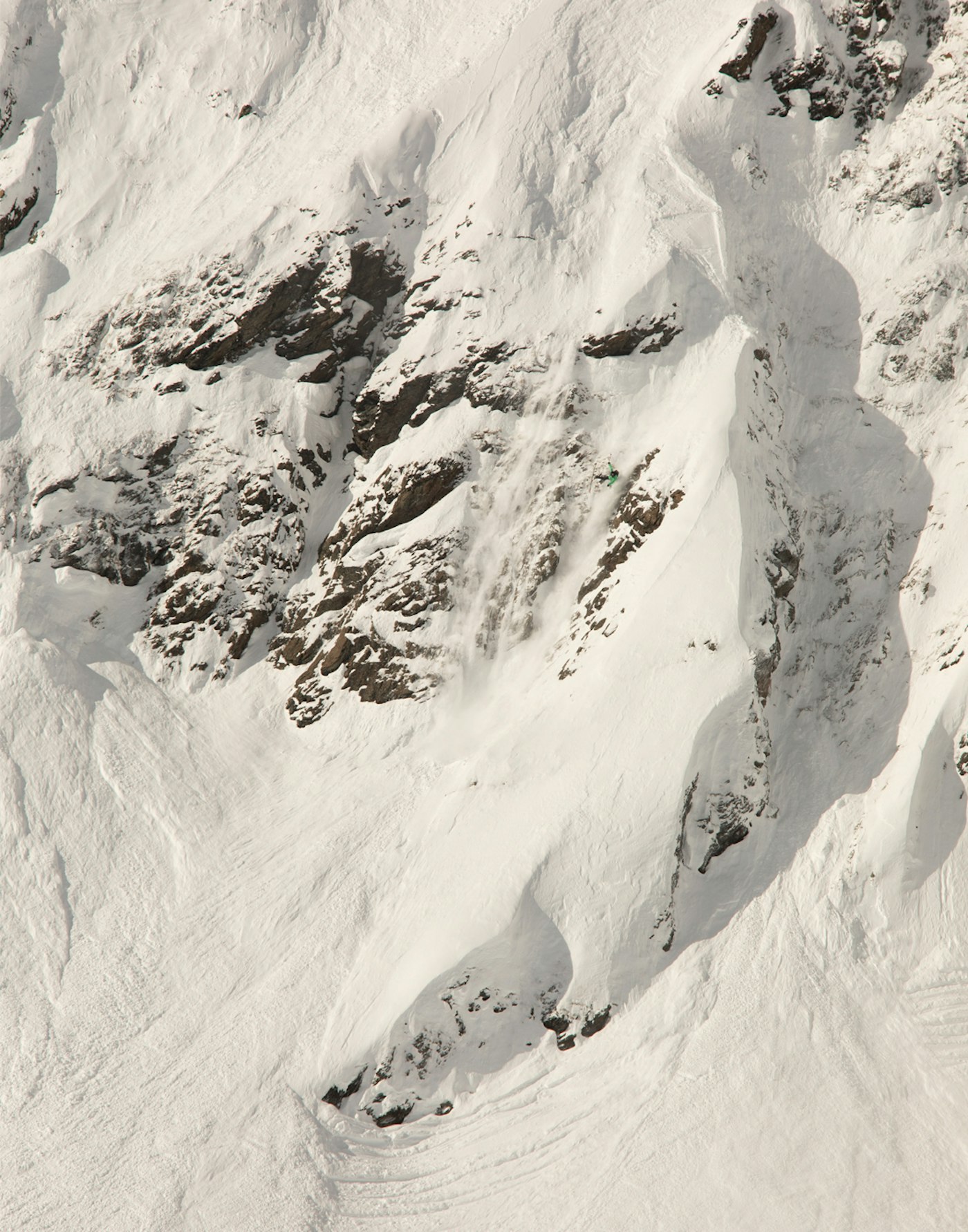
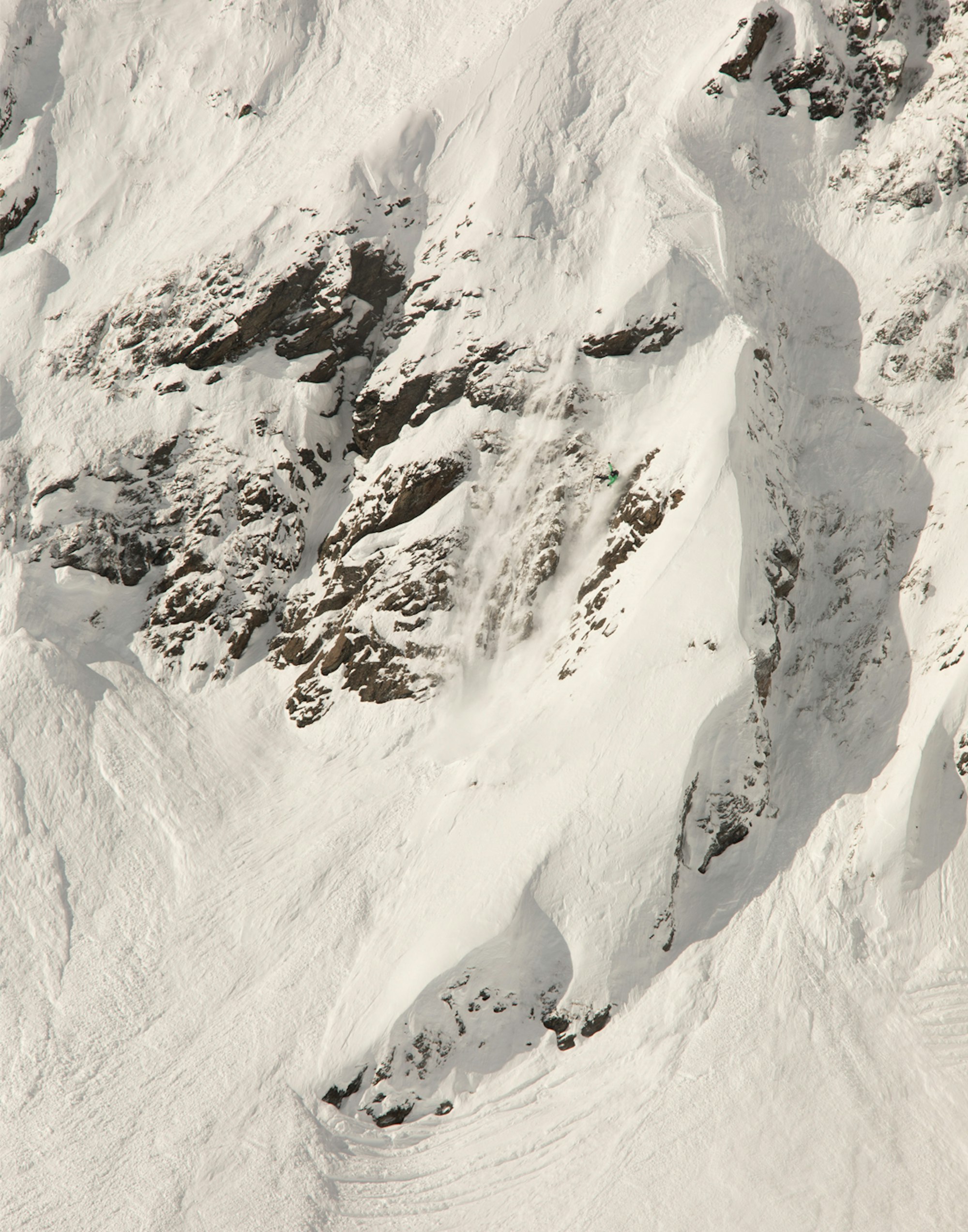
From top left: Smoothy drops into his line; waiting out the slough train; taking a ride into the rocks below.
We live in an age of incredible feats of athletic daring; images of the unbelievable flood our lives like never before and are widely celebrated. The level of performance in action sports is actually insane and progression seems to have no end. There is good money to be made by those who claw their way to the top of the pile, muddying the mental waters even further. The cost these celluloid heroes pay is well-documented, featuring, for all the world to see, tragic accidents and loss of life that seem to occur much too frequently. The horrific pain the families endure cuts long and deep well after the headlines have faded.
I never considered myself a high-risk taker, thinking I had a good handle on the limit of my abilities. I always played a fairly straight hand with avalanche safety and had no major incidents prior to this one. My accident was unnerving; it made me anxious thinking it was overdue because of the frequency of my trips into the backcountry. In the classic timeline of the hero’s journey, the initial defeat is often where great insight occurs. After what could have easily been my last run ever, I found myself in that moment.
I asked a Chamonix hell-man-ski-mountaineer if he could be happy skiing much mellower runs, to limit his risk because he had just become a father. He calmly said he wouldn’t be himself if he skied any differently, that skiing big exposed lines was an integral part of his being and he wouldn’t be happy stepping away from it. I can understand, but at the same time it made me feel very uneasy. I started to examine what I love about my life and what I held important as a human. Which led me to ask, “What can I do to create an attitude and environment best suited to help me succeed?”
Initially, I settled on becoming a second-rate barista living out of a van at some hidden point break and surfing my life away. This plan quickly faltered, because I knew I needed to find a balance between being true to myself and being fair to those who love me. I came to believe that my effect on others was my responsibility to manage.
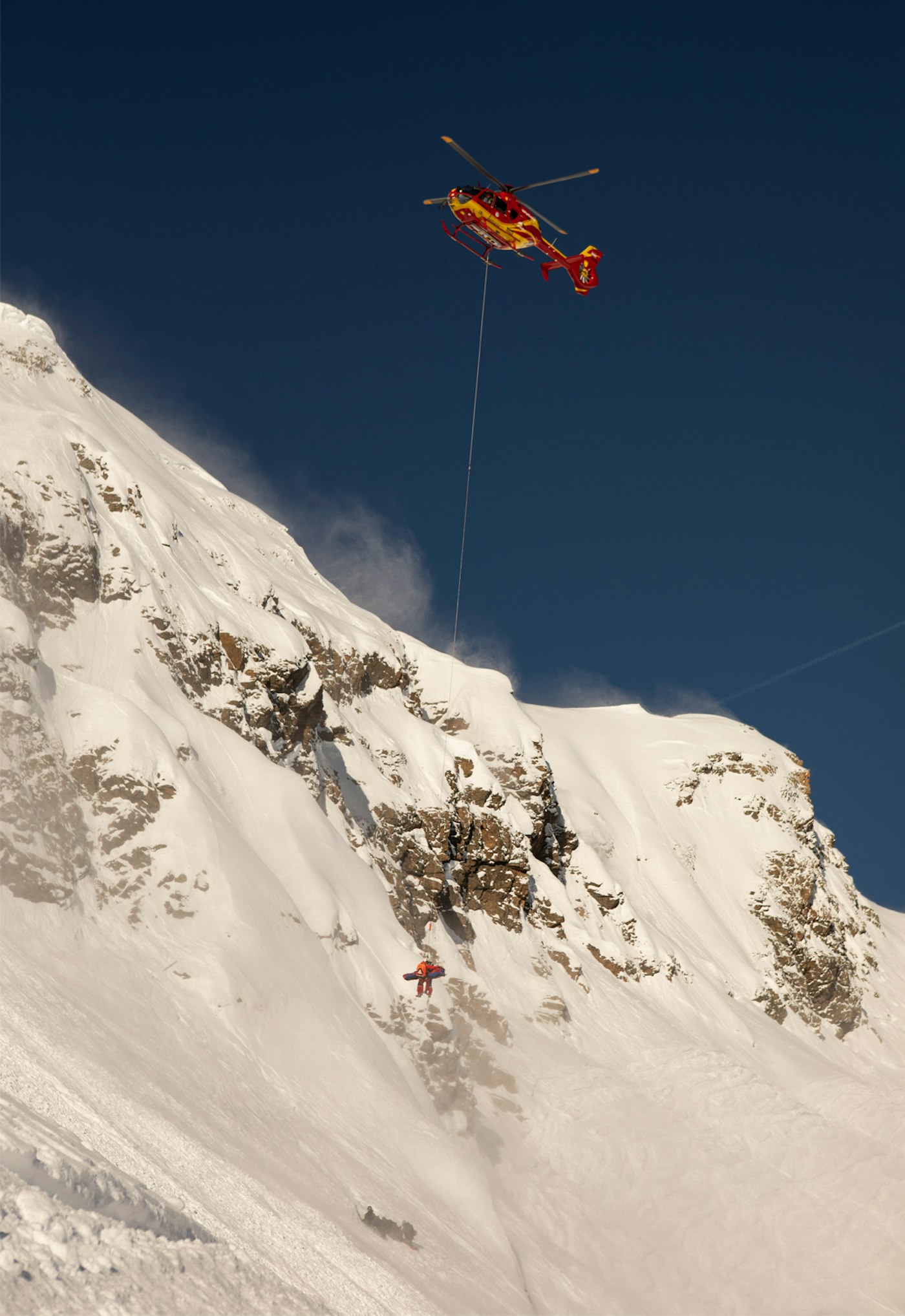
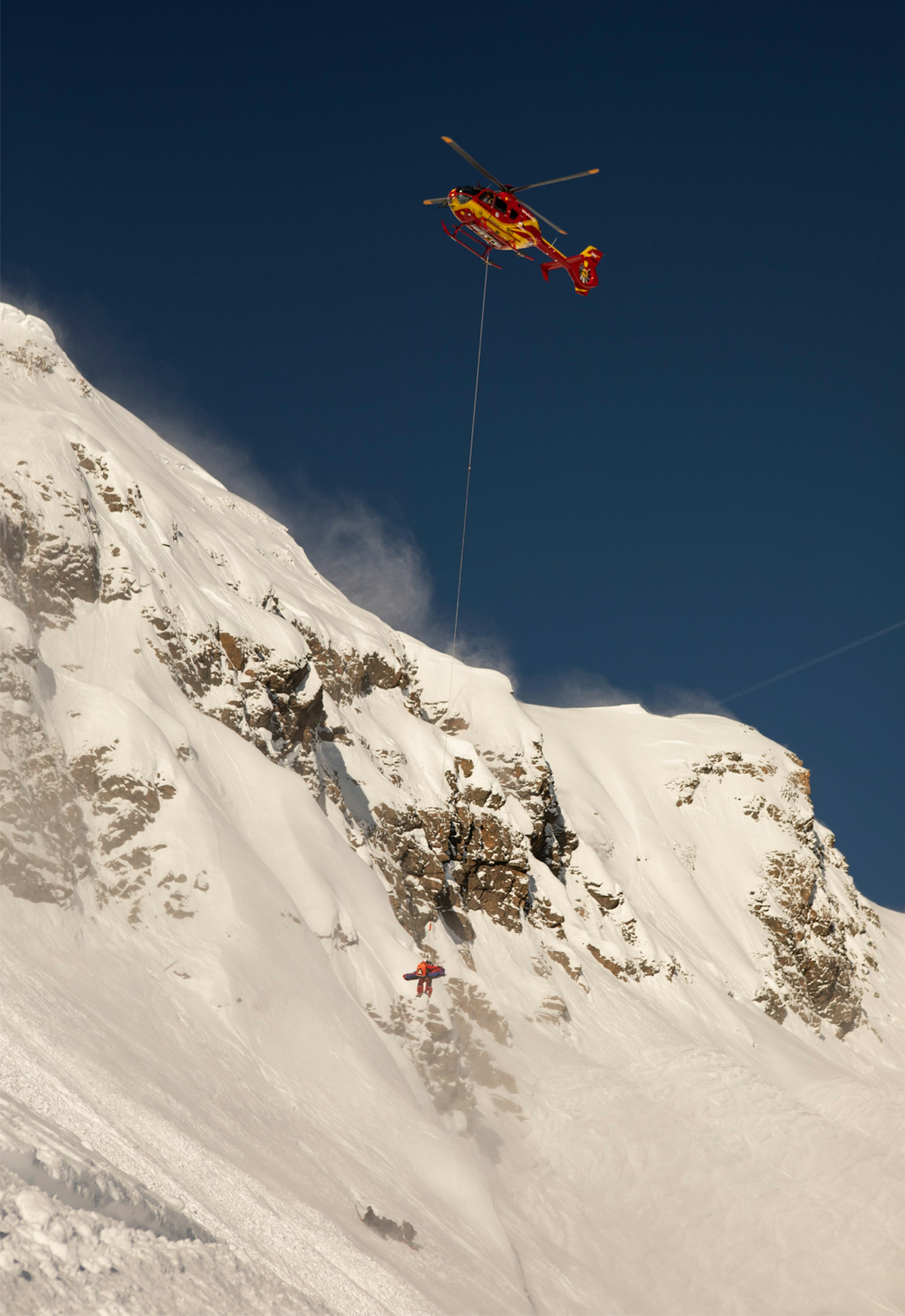
I discovered a few common-sense precautions that allowed me to continue to do what I loved but gave me a better shot at surviving while avoiding the barista gig. Backcountry safety education, apprenticeships under more experienced skiers and medical courses, to name a few. Give yourself a wee pat on the head if you’ve done those. But then take a minute to truly look at your decisions and see how often you are putting that knowledge into practice. Are you following a methodical line of reasoning, working with your group and putting these methods into practice every single time you’re out in the line of fire? Are there occasions where your froth, based on conditions, time pressures or desire to perform the magnificent, have led you to cutting corners?
My surrogate parent’s favorite line is, “Never let school get in the way of your education,” which I hold to mean that every day is a learning experience and should be treated as such. That you should always strive to better yourself and those around you. Don’t just tick the box that you have learned backcountry safety, it simply does not work like that. Backcountry skiing is an ever-evolving and changing artform; a complex network of variables that are your responsibility to understand and manage. To me, the piece that often gets overlooked is an honest and in-depth assessment of your decisions and performance. A lack of accidents doesn’t mean you haven’t cheated yourself and your partners at some point. It has to be OK to assess yourself and each other to understand how you can manage these life-or-death situations in the future without feeling pressured, judged or attacked. While skiing is an individual sport, safe backcountry travel is a team affair and needs to be treated as such.
I believe that our ambitions are the slipperiest variable and are the most likely to lead us astray. They are also the hardest to assess, as they quickly shift hour to hour in the backcountry, often due to the excitement of operating in an electrifying environment. You head out aware of the potential risks and keen for some mellow pow turns. You skin for a few hours and discover a burly line and a camera buddy is already out in the zone. It’s steeper on the aspect of concern, but man, the shot will be insane! Ripping into the line, a small pocket pops a third of the way down and while small, it’s enough to set you running blind off a cliff and smack straight into the hospital with a fractured femur. While it may have been the photographer’s idea, it was your ambition to get published that led you to override your previous decision. And thus, it is your accident alone to own.
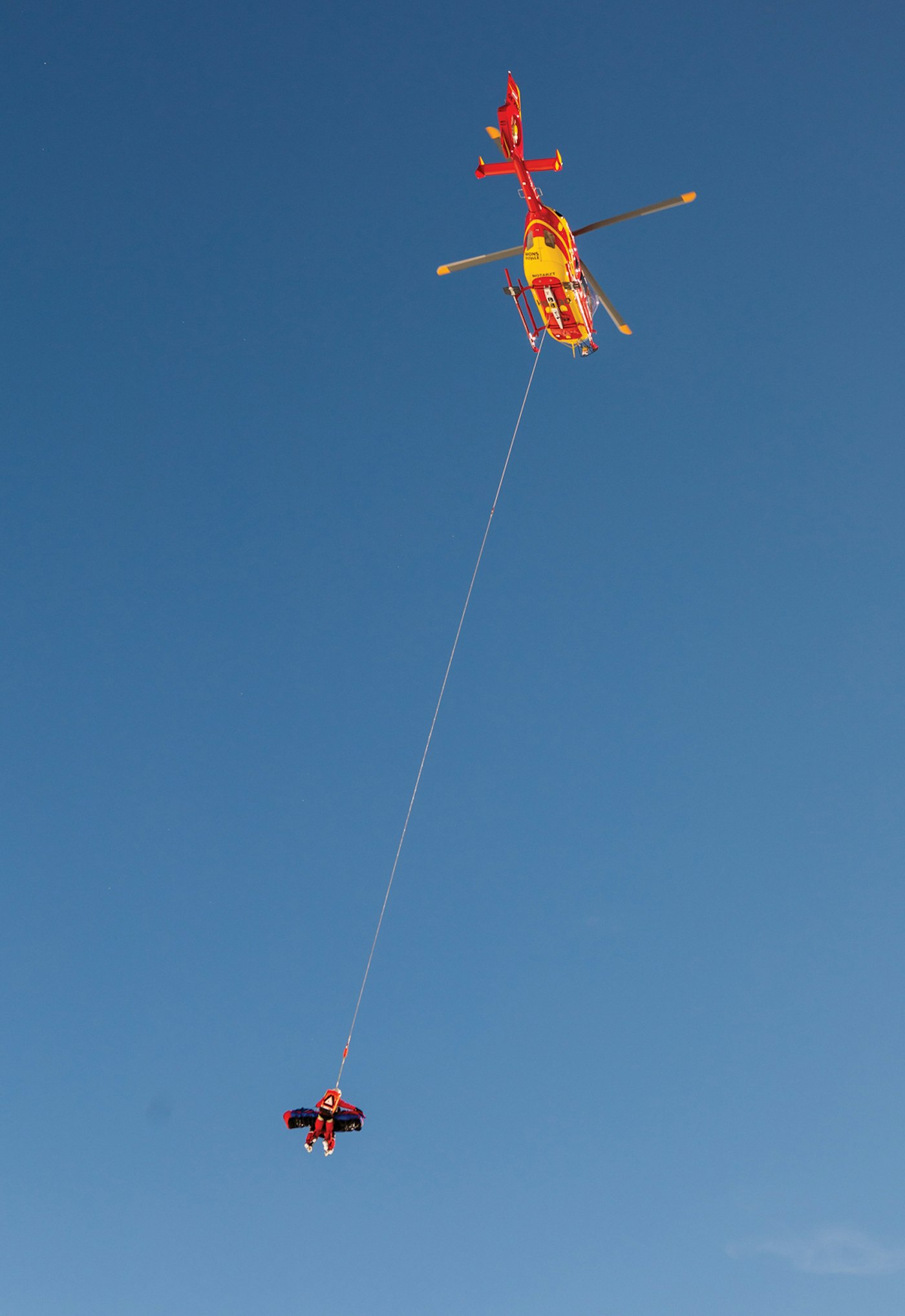
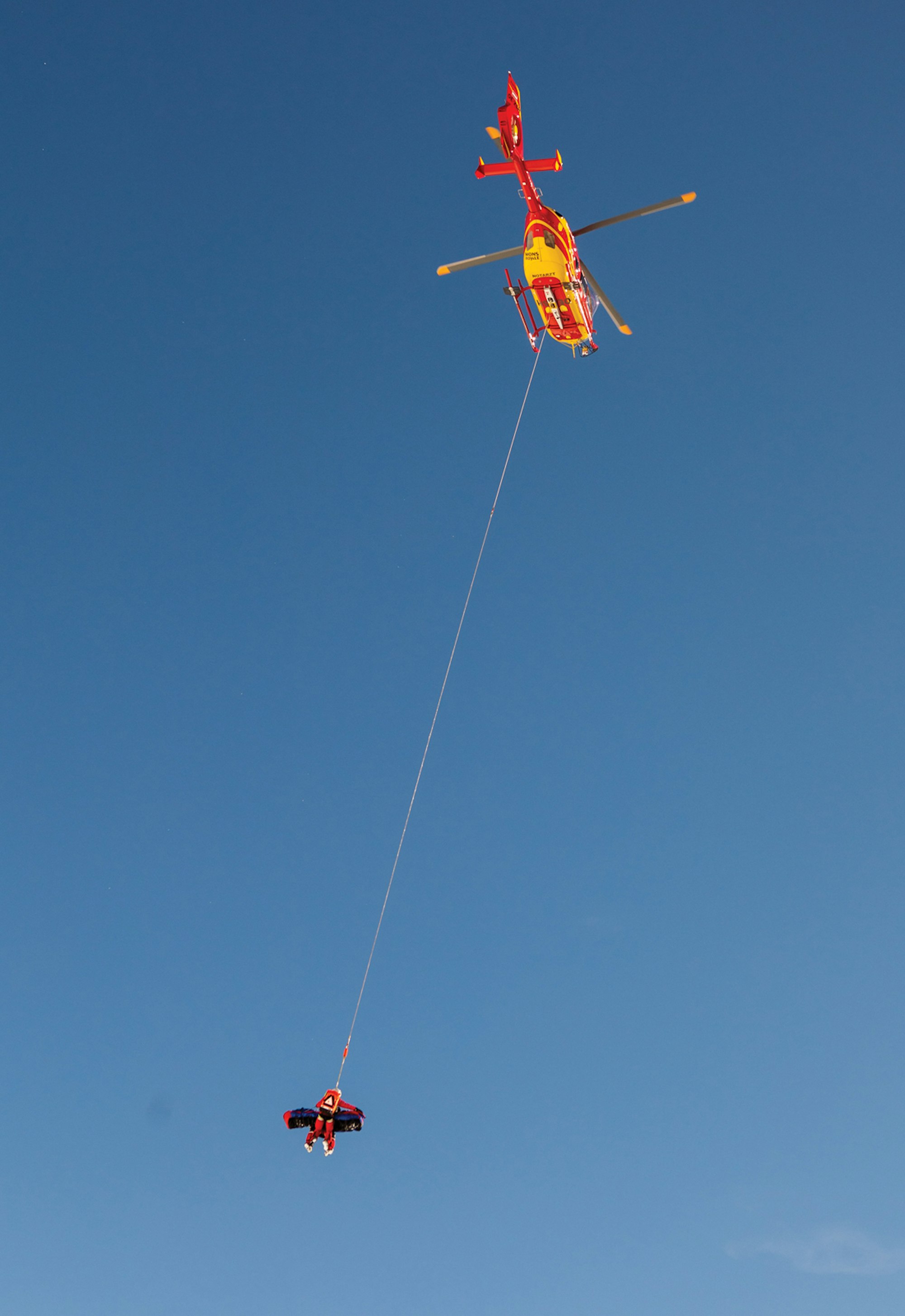
We can amass all the knowledge possible, but if we don’t truly understand what our goals and their inherent risks are, and what motivations or pressures we feel, corners will get cut, chewed up and spit out on the mountain in real-time. How good that achievement will feel versus how bad the potential outcome might be needs to be constantly evaluated. The impact on your larger life ambitions and for those around you must be taken into account before you drop. Your inner self is an elusive beast; you may not be aware of the varying pressures or desires affecting your decision-making, but it’s imperative to sit back and dispassionately assess the mental factors involved. Having a solid group of partners who you can go over this with and honestly appraise each other without fear or mistrust is a great way to gain further insight.
To be able to climb and ski in big exposure is to be truly vulnerable, which is a beautiful and humbling experience. I know and love that feeling of high-end lines and will take on more of them in the future. But I also know it is not the only amazing experience in life and I will strive to increase my margin of safety, to do all I can to ensure a future bright with rich experiences with those I love. In the unforgiving mountains your armour is your physical skill, your team and, most important, your mind. Tread lightly and stay true to those checks and balances that will get you home safe. Then you can do it all again tomorrow.
This story originally appeared in FREESKIER 22.3, The Backcountry Issue.

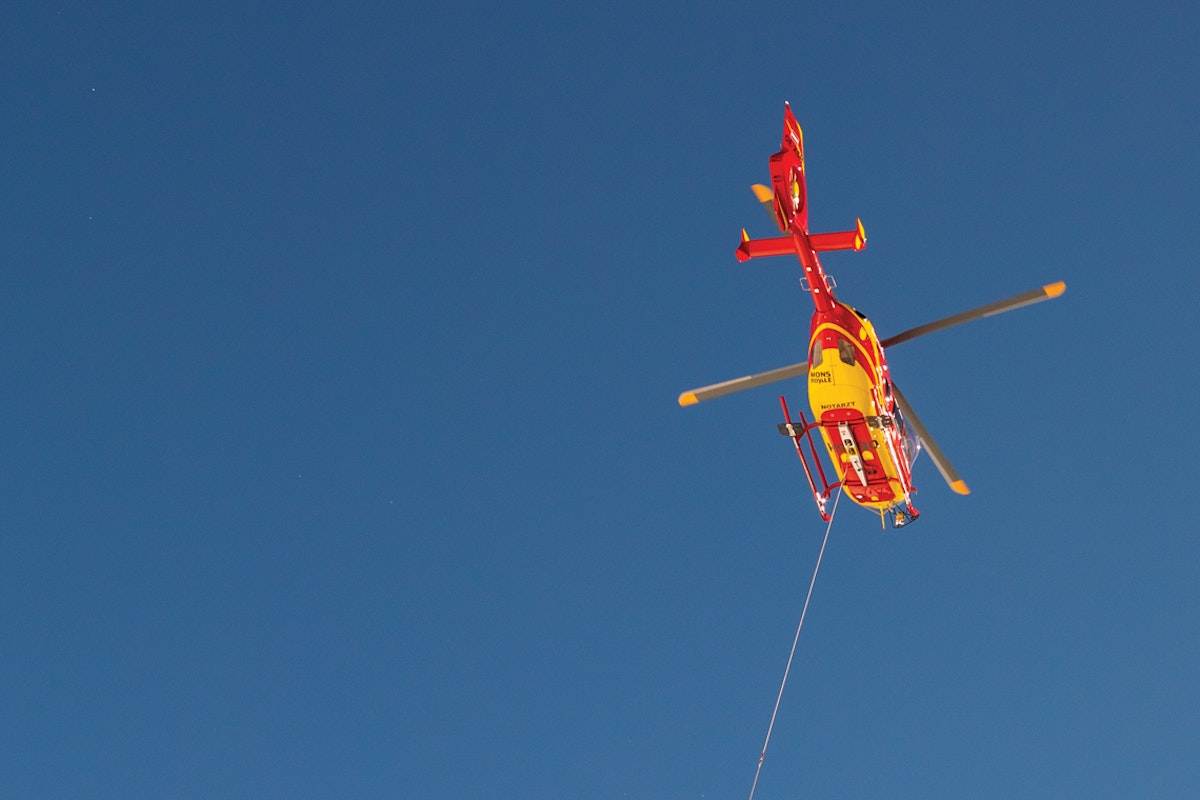

![[GIVEAWAY] Win a 4-Night Karma Campervan Rental and go Ski the Powder Highway](https://www.datocms-assets.com/163516/1767816935-copy-of-dji_0608-1.jpg?w=200&h=200&fit=crop)


![[GIVEAWAY] Win a Legendary Ski Trip with Icelantic's Road to the Rocks](https://www.datocms-assets.com/163516/1765233064-r2r26_freeskier_leaderboard1.jpg?auto=format&w=400&h=300&fit=crop&crop=faces,entropy)
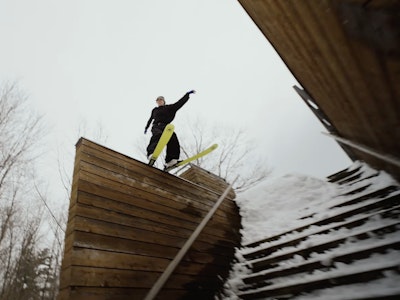
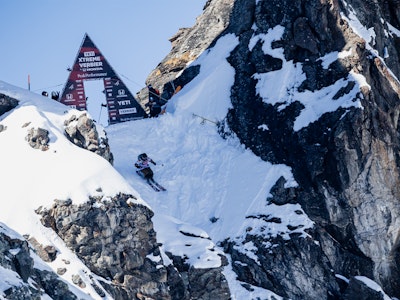
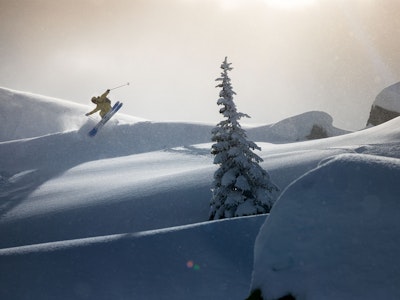


![[GIVEAWAY] Win a 4-Night Karma Campervan Rental and go Ski the Powder Highway](https://www.datocms-assets.com/163516/1767816935-copy-of-dji_0608-1.jpg?auto=format&w=400&h=300&fit=crop&crop=faces,entropy)

